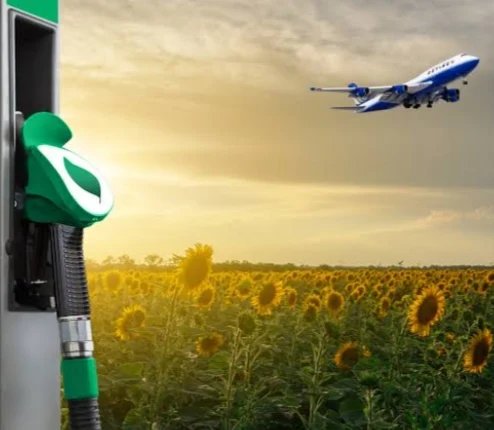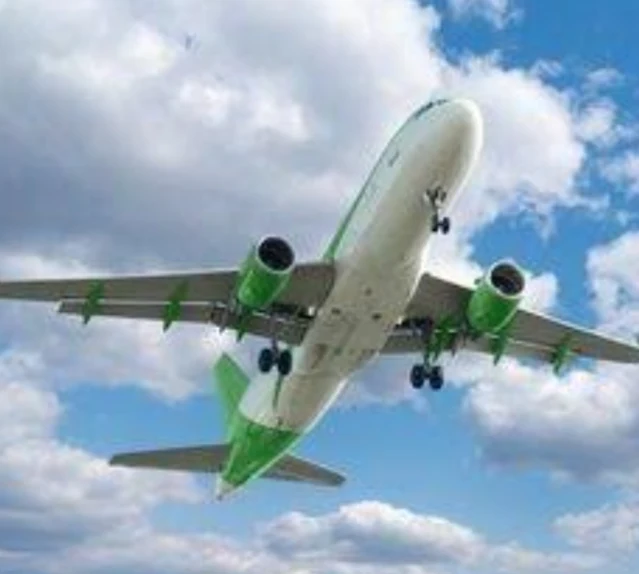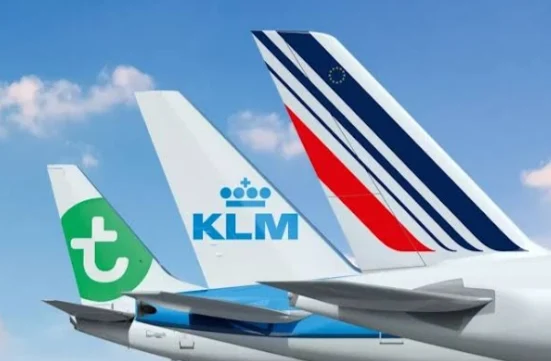Sustainable Aviation Fuel (SAF) Landscape in Europe
The European aviation industry is facing the challenge of reducing its environmental impact, and Sustainable Aviation Fuel (SAF) is seen as one of the most promising solutions.
SAF is a drop-in fuel that can be used in existing aircraft engines without any modifications, but it is produced from renewable sources such as biomass, waste oils, and even captured CO2. This means that SAF can significantly reduce the lifecycle greenhouse gas emissions of aviation compared to conventional fossil jet fuel.
What it Sustainable Aviation Fuel (SAF) ?
Sustainable Aviation Fuel (SAF) is an alternative fuel for airplanes that reduces greenhouse gas emissions compared to traditional jet fuel. It's made from renewable sources like plant oils, waste fats, and even captured carbon dioxide, all of which can be processed into a fuel that has similar properties to conventional jet fuel.
Here's a breakdown of SAF:
- A drop-in fuel, meaning it can be used in existing aircraft engines without any modifications.
- Made from renewable sources like:
- Biomass: jatropha, algae, switchgrass
- Waste oils: used cooking oil, animal fats
- Captured carbon dioxide: air capture or industrial waste streams
SAF is a promising solution for reducing the environmental impact of aviation. With continued investment and innovation, SAF has the potential to play a major role in decarbonizing the aviation sector and helping to meet climate goals.
Here's a snapshot of the current SAF landscape in Europe:
- Policy and Regulation: The European Commission has proposed a blending mandate for SAF, requiring that 2% of all jet fuel supplied at EU airports must be SAF by 2025, rising to 63% by 2050. This is expected to create a significant market for SAF and drive investment in production capacity.
- Production and Capacity: Currently, the production of SAF in Europe is limited, with a maximum potential capacity of around 0.24 million tonnes per year. This is only about 10% of the amount needed to meet the proposed blending mandate by 2030. However, several new SAF production facilities are planned or under construction, and the industry is expected to grow rapidly in the coming years.
- Cost and Availability: SAF is currently more expensive than conventional jet fuel, due to the higher costs of production and feedstocks. However, the cost is expected to decrease as production scales up and new technologies are developed. The availability of SAF is also limited, but it is becoming increasingly available at major airports in Europe.
- Challenges and Opportunities: Some of the challenges facing the SAF industry in Europe include the need for further investment in production capacity, the development of a robust regulatory framework, and the need to ensure the sustainability of feedstocks. However, there are also many opportunities for the industry, such as the potential to create new jobs and green growth, and to contribute to the decarbonization of the aviation sector.
The SAF landscape in Europe is evolving rapidly, and the future looks promising. With the right policies and investments, SAF has the potential to play a major role in reducing the environmental impact of aviation in Europe.
Number of Sustainable Aviation Airlines in Europe
To give you the most comprehensive picture of airlines in Europe engaged in sustainable aviation practices, I've combined the three approaches from my previous answer:
1. Airlines actively using and promoting SAF:
- Major Airlines: Lufthansa, KLM, Air France, British Airways, SAS (varying levels of SAF use and commitment)
- Sustainability-focused Airlines: Volotea (carbon neutrality by 2050), Icelandair (net-zero by 2041), Finnair (carbon neutrality by 2045)
2. Airlines associated with sustainability organizations:
- Airlines for Europe (A4E): All members use SAF and have net-zero 2050 goals.
- Clean Skies for Tomorrow initiative: Members include airlines, airports, fuel suppliers, and technology companies working to accelerate SAF deployment in Europe.
3. Airlines investing in SAF production and research:
- Lufthansa partnering with Neste on a major SAF production facility in Finland.
Table of Sustainable Aviation Airlines in Europe
Sustainable Aviation Airlines in Europe: A Comparison
| Category | Airlines | Approach to Sustainability | Additional Notes |
|---|---|---|---|
| Major Airlines with SAF Use: | Lufthansa, KLM, Air France, British Airways, SAS | Varying levels of SAF usage & commitment. Not all have net-zero goals. | Focus on increasing SAF usage and investment in production. |
| Sustainability-Focused Airlines: | Volotea, Icelandair, Finnair | Dedicated to sustainability with ambitious net-zero goals. Early adopters of SAF. | Implement broader sustainability initiatives beyond SAF. |
| Airlines for Europe (A4E) Members: | Multiple European Airlines (see A4E website) | All use SAF and have net-zero 2050 goals. Strong collective commitment. | Collaboration on policy, best practices, and SAF initiatives. |
| Clean Skies for Tomorrow Members: | Airlines, airports, fuel suppliers, technology companies | Diverse stakeholder collaboration to accelerate SAF deployment. | Focus on infrastructure, standards, and market development. |
| Airlines Investing in SAF Production: | Lufthansa (partnership with Neste) | Proactive involvement in expanding SAF production capacity. | Secure long-term fuel supply and drive innovation. |
Notes:
- This table is not exhaustive and represents a selection of notable examples.
- The "Category" labels are descriptive and not rigid classifications.
- Some airlines fall into multiple categories.
- Consider researching individual airlines for deeper insights into their specific sustainability programs and goals.
Resources:
- Airlines for Europe: https://a4e.eu/: https://a4e.eu/
- Clean Skies for Tomorrow: https://www.weforum.org/publications/clean-skies-for-tomorrow-sustainable-aviation-fuels-as-a-pathway-to-net-zero-aviation/: https://www.weforum.org/publications/clean-skies-for-tomorrow-sustainable-aviation-fuels-as-a-pathway-to-net-zero-aviation/
- European Commission - ReFuelEU Aviation: https://www.consilium.europa.eu/en/press/press-releases/2023/10/09/refueleu-aviation-initiative-council-adopts-new-law-to-decarbonise-the-aviation-sector/: https://www.consilium.europa.eu/en/press/press-releases/2023/10/09/refueleu-aviation-initiative-council-adopts-new-law-to-decarbonise-the-aviation-sector/
Sustainable Aviation Fuel (SAF) Production Company in Europe
There are several promising Sustainable Aviation Fuel (SAF) production companies in Europe, each with its own focus and technology. Here are some notable examples:
Neste:
- Finnish company, the world's leading producer of SAF with a current annual capacity of 1 million tonnes.
- Utilizes hydrotreated vegetable oils (HVO) technology to convert waste oils and fats into renewable hydrocarbons.
- Partners with major airlines like Lufthansa and KLM to supply SAF.
Verbio:
- German company specializing in advanced biofuels, including SAF.
- Employs biomass gasification technology to convert wood residues and organic waste into synthetic fuels.
- Operates multiple production facilities across Europe.
Vivergo:
- Dutch company producing SAF from renewable feedstocks like corn stover and wheat straw.
- Utilizes biochemical conversion technology to break down the feedstocks into sugars and ferment them into ethanol, then converted into SAF.
- Has plans for new production facilities in France and Romania.
HEFA:
- German company focused on Power-to-Liquid (PtL) technology, producing SAF from captured CO2 and renewable electricity.
- Offers an alternative pathway to traditional biomass-based SAF.
- Partners with Porsche and other companies to demonstrate and scale up PtL technology.
Other notable companies:
- SkyNRG: Dutch company specializing in blending and supplying SAF.
- TOTAL: French energy giant investing in various SAF production technologies.
- Neste MY Renewable Diesel: Neste subsidiary producing HVO-based fuels, including SAF.
- Renewable Energy Group: Norwegian company exploring PtL and other SAF technologies.
Considerations when choosing SAF producers:
- Feedstock type: Different feedstocks have varying sustainability implications. Opt for companies prioritizing waste fats and residues over virgin biomass.
- Production technology: Consider the environmental impact and efficiency of the chosen technology. PtL may have lower lifecycle emissions than biomass-based methods.
- Transparency and certification: Choose companies with clear sustainability goals and certified SAF production processes.
Table of Sustainable Aviation Fuel (SAF) Production Companies in Europe
Sustainable Aviation Fuel (SAF) Production Companies in Europe: A Comparison
| Company | Focus | Technology | Feedstock | Current Capacity | Notable Partnerships |
|---|---|---|---|---|---|
| Neste | Leading producer | HVO | Waste oils & fats | 1 million tonnes/year | Lufthansa, KLM, Air France |
| Verbio | Advanced Biofuels | Biomass gasification | Wood residues, organic waste | Multiple facilities across Europe | None listed |
| Vivergo | Corn stover & Wheat straw | Biochemical conversion | Corn stover, wheat straw | Expansion plans (France, Romania) | SkyNRG |
| HEFA | Power-to-Liquid (PtL) | Captured CO2 & renewable electricity | CO2, renewable electricity | Demonstration phase | Porsche, other companies |
| Other notable companies: | |||||
| SkyNRG | Blending & supply | Various | Various | Not applicable | Airlines, fuel suppliers |
| TOTAL | Diverse SAF technologies | Various | Various | Investments in multiple companies | Airlines, energy companies |
| Neste MY Renewable Diesel | HVO-based fuels (incl. SAF) | HVO | Waste oils & fats | Not specified | Airlines, distributors |
| Renewable Energy Group | PtL & other SAF technologies | PtL, others | Various | Research & development stage | Airlines, technology partners |
Notes:
- This table highlights a selection of promising companies and is not exhaustive.
- Capacities and partnerships may change over time.
Conclusion Sustainable Aviation Fuel (SAF) Lansdcape in Europe
The Sustainable Aviation Fuel (SAF) landscape in Europe is brimming with both promise and challenges.
On the one hand, ambitious policy mandates, growing investment in production facilities, and increasing adoption by airlines, like early adopters such as Volotea and Icelandair, paint a picture of a significant shift towards a greener future for aviation. Technological advancements like Power-to-Liquid (PtL) offer further pathways to reduce reliance on fossil fuels.
However, hurdles remain. Current production capacity lags behind the demand projected by the blending mandates, and the cost of SAF remains higher than conventional jet fuel. Concerns about the sustainability of some feedstocks and ensuring ethical sourcing also require careful consideration.
The momentum behind SAF in Europe is undeniable. With continued collaboration between policymakers, airlines, fuel producers, and researchers, the continent has the potential to become a global leader in the development and deployment of this critical technology. By tackling the remaining challenges head-on, Europe can pave the way for a future where the skies are truly sustainable.







